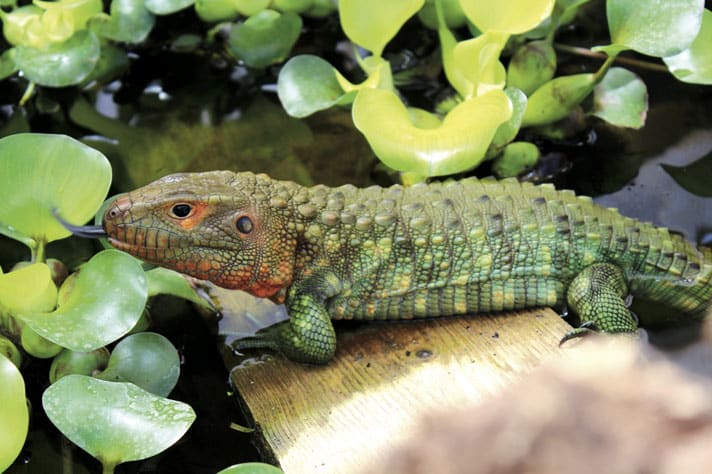Care for the caiman lizard, denizen of the Amazon River.
The caiman lizard (Dracaena guianensis) is a large, heavy-bodied lizard that is well-adapted to life in and around water. It is native to South America around the Amazon River Basin from Brazil and Guyana, westward to Peru and Ecuador, and while it is a relatively widespread species, little has been published about wild populations. In the past, the caiman lizard was heavily hunted for its skin, but since protection was provided in the 1970s, export has dropped and it is no longer considered to be under the threat of extinction.
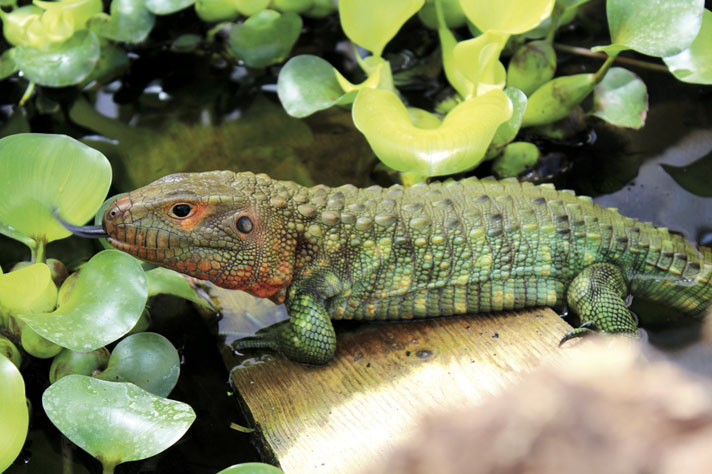
Ashley Rademacher
Previously, the vast majority of caiman lizards encountered in the pet trade were wild-collected specimens that were difficult to care for. Today, due to this species’ CITES Appendix II status, captive-bred specimens have become increasingly common, and keepers have enjoyed greater success in maintaining them. Still, this lizard has specialized requirements and should be kept only by long-time enthusiasts who can provide the proper care.
The caiman lizard is one of the largest lizards found in the Americas. While females can grow up to 4 feet, males may reach up to 5 feet in total length and weigh 8 to 12 pounds. One of the easiest ways to identify a caiman lizard is by its unique color pattern. The body is olive to bright green, with a red or orange head. The thick tail is brownish to black and may exhibit yellow stripes. Adults display some degree of sexual dimorphism; the male has a broader head that is brighter red than that of the female. Covered in large bony scales, the skin resembles that of a caiman, a crocodilian species that also inhabits Central and South America. While its appearance and semi-aquatic lifestyle may suggest that the caiman lizard is related to its crocodilian namesake, it is actually a cousin of the tegu and is just as well-equipped for life on land and in the trees as it is in the water. Strong legs and razor-sharp toenails make the caiman lizard an agile climber among trees and branches.
Special Adaptations for Caiman Lizards
The caiman lizard has a thick, laterally flattened tail that provides powerful propulsion through the water. It swims much like a crocodile, by undulating from side to side and tucking its short legs in close to the body. The tail has two bony dorsal ridges that span from the animal’s back nearly to the tip of the tail, where they come together. The tail also provides balance for the caiman lizard’s arboreal activities. The eyes are equipped with clear, third eyelids called nictitating membranes, which close when the animal submerges itself, protecting the eyes and assisting in underwater vision. Given that caiman lizards feed largely on aquatic prey, this is a very important adaptation.
Caiman Lizards are Specialized Eaters
The caiman lizard has a specialized diet that consists mainly of large aquatic snails, which requires some special adaptations. The lizard’s flattened, molar-like teeth and powerful neck and jaw muscles enable it to crush and consume this favorite food. When eating a snail whole, a caiman lizard will tip its head back, positioning the snail between its molars. After crushing the shell, the lizard will swallow the soft flesh of the snail and spit out the shell. The lizard’s incredibly strong muscles and unique dentition also aid it in consuming crawfish, clams, mollusks and other hard-shelled invertebrates.
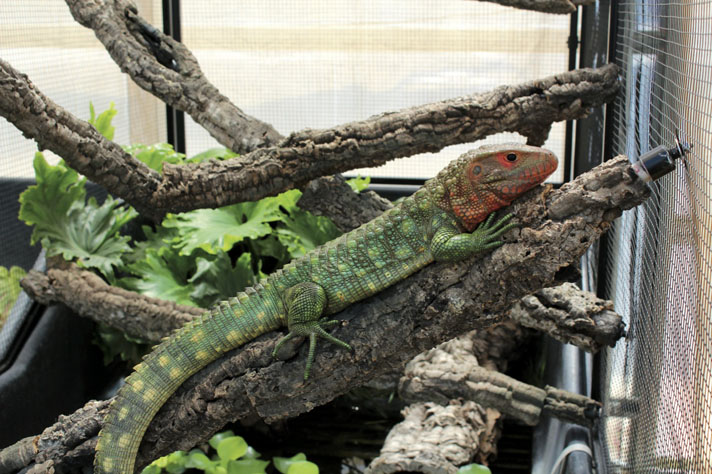
Ashley Rademacher
Strong legs and razor-sharp toenails allow these animals to easily climb trees and branches. Be sure to provide strong branches upon which pet lizards can bask.
Caiman Lizards Are Seldom Far From Water
These highly aquatic lizards seldom venture far from the water. Wild specimens typically rest and bask on tree branches that overhang water, and when threatened they will dive in and quickly swim away.
The caiman lizard is not aggressive by nature, but if threatened, it is certainly armed to defend itself. The tail can be used as a very strong whip in protecting this lizard from a potential threat, and predators should also be wary of the fearsome jaw strength that the caiman lizard possesses. Although it does not possess a mouth full of sharp teeth such as its crocodilian namesake, the incredible power of the lizard’s strong jaw muscles can help this species to deliver a painful bite.
Large Enclosures for Caiman Lizards are a Must
With caiman lizards, the first and most important consideration is size. With the likelihood of reaching 4 feet or longer, an adult will need an exceptionally large enclosure. Juveniles can be housed in an enclosure that is at least comparable in size to a 55-gallon aquarium: 4 feet long, 1 foot wide and at least 2 feet tall. An enclosure for a single adult should measure at least 6 feet long, 3 feet wide and 4 feet tall (a modified Extra-Large Waterland Tub works well). A large water area should be provided, as well as a land area and plenty of vertical space with climbing opportunities.
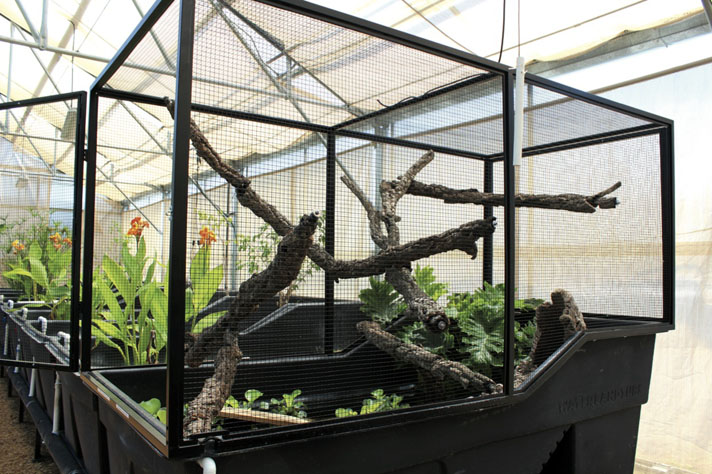
courtesy david Fontes
A pair of caiman lizards housed at Zoo Med Labs lives in this custom enclosure inside a greenhouse. The bottom consists of an extra large Waterland Tub, with a custom, powder-coated wire mesh cage built on top. The enclosure measures 8 feet long, 4 feet wide and 6 feet tall. The water area is 16 inches deep and about 5 feet long.
Provide Clean Water for Caiman Lizards
Caiman lizards are excellent swimmers and should be able to fully submerge themselves in water. Provide adults a minimum water depth of 12 inches so they may practice natural swimming behaviors. Water should be kept between 75 and 85 degrees Fahrenheit, maintained by a submersible aquarium heater. Caiman lizards can be messy eaters and will produce large amounts of waste that will usually end up in the water. A large, high-quality aquarium filter can help keep water clean but will not eliminate the need for frequent water changes of at least once a week, and more likely, two to three times a week. Without a filter the water will probably have to be changed once or even twice a day.
Aquarium gravel is not recommended in the water area, as it can be accidentally ingested and could cause gastrointestinal impaction. Large river stones (too large to fit in the lizard’s mouth) may be used in the water for a naturalistic look, but waste and food particles may become trapped between them and foul the water more quickly. A bare-bottomed water area is safe and the easiest to maintain.
Substrate and Décor for the Caiman Lizard
Several different substrates may be used. We use a combination that contains cypress mulch, Zoo Med Eco Earth and clean sand to help maintain high, tropical humidity and allow for some natural digging behavior. A shelter is also very important for young lizards; a Habba Hut or cork round can be used. The shelter should be large enough to completely hide the animal. For a young caiman lizard, a shelter that is 6 inches wide, 10 inches long and about 4 inches tall would be fine. An adult would need one that is at least 18 to 24 inches long, 12-plus inches wide and a minimum of 8 to 10 inches tall.
These large lizards may tear up some live plants, but robust plants can be used to add a naturalistic look, increase humidity and provide cover. Artificial plants may also be used to provide cover and a naturalistic look to the enclosure. Plenty of sturdy climbing branches should be provided around, and especially over, the water area. Large cork branches or Mopani wood can be placed partially in the water to create basking areas. Be sure that branches are secure, as caiman lizards love to climb and dig, and they may knock over unsecured cage decorations.
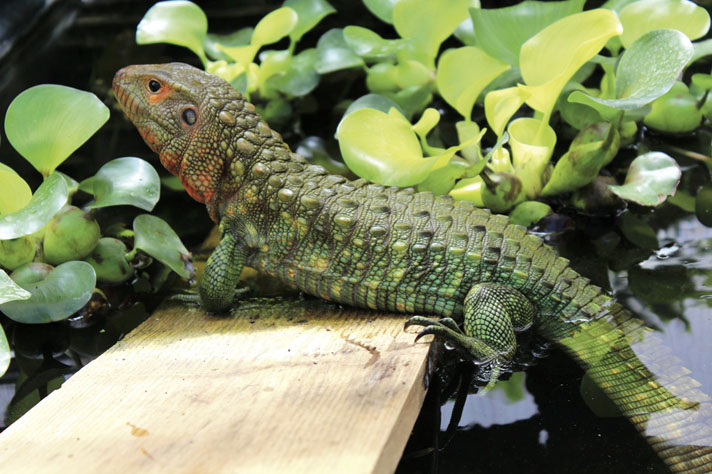
courtesy david Fontes
Caiman lizards are one of the largest lizards found in the Americas. While females can grow up to 4 feet, males may reach up to 5 feet in total length and weigh 8 to 12 pounds.
Ideal Caiman Lizard Temperatures
Caiman lizards are tropical animals that require warm temperatures year-round in order to thrive. Daytime ambient temperatures should be maintained between 80 and 90 degrees, with a basking area of 100 to 105 degrees. Nighttime temperatures should not fall below 75 degrees.
There are several different heating elements that may be used to maintain a proper thermal gradient in a caiman lizard enclosure. We use a ReptiHalogen spot lamp for the basking area. The bulb burns hotter than a standard basking lamp, which can be very helpful when heating a large enclosure.
Caiman lizards spend a good portion of the day basking, so provide a branch that is able to safely and comfortably hold the animal’s weight. If more than one lizard is kept in an enclosure, provide multiple basking areas to prevent competition over basking resources. Additional heating elements, such as ceramic heat emitters and nocturnal infrared heat lamps, may be used to provide supplemental heat when necessary. Because caiman lizards can be active swimmers it is important to protect heat lamps from splashes, or to use a splash-proof lamp.
While little is known about the UVB requirements of caiman lizards, providing UVB is highly recommended. For many reptiles, proper exposure to UVB lighting allows them to manufacture their own vitamin D3, which is essential for calcium metabolism. Access to proper UVB lighting can, in turn, help prevent and even reverse metabolic bone disease (MBD) in many reptiles. Another important part of the light spectrum is UVA, which promotes natural behaviors, such as feeding and breeding.
In order to maintain healthy caiman lizards, a 12- to 14-hour daylight period with access to UVA, UVB and full-spectrum visible daylight should be provided. In our indoor enclosure, we use a High-Output T5 ReptiSun 5.0 to provide UVB, UVA and visible daylight. A timer is used to automatically supply a consistent 12-hour photoperiod.
Caiman Lizards Need High Humidity
Humidity levels for caiman lizards should be maintained between 60 and 80 percent. Use of moisture-retaining substrates, such as Forest Floor, Eco Earth and mosses, can help to maintain the proper levels, and a hygrometer can be used to keep track.
In an enclosure with solid walls, such as glass, high-humidity levels are easy to maintain. As your caiman lizard grows to its maximum potential, however, a glass terrarium will hardly be appropriate housing. A custom enclosure will likely be needed.
An automatic misting system or Reptifogger provides an easy way to mist the terrarium daily to achieve the required moisture levels. In our large greenhouse enclosure, humidity levels rarely drop below 70 percent. An automatic mister runs for 10 minutes twice daily, and supplemental manual misting is provided as needed. A water source, with a large surface area and the addition of live plants, will also increase humidity.
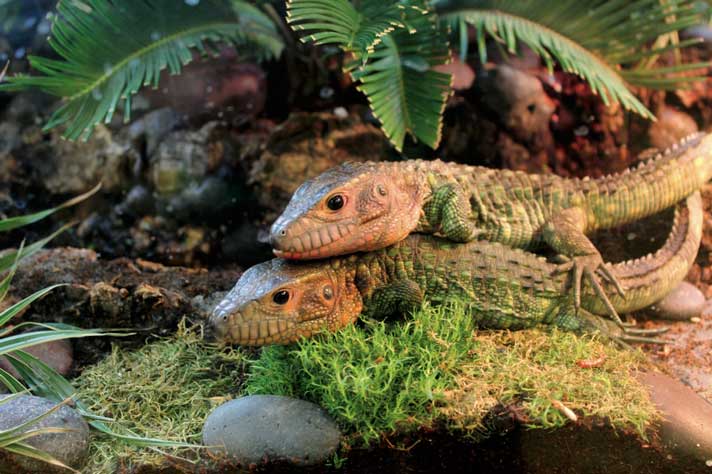
COURTESY DAVID FONTES
Dracaena guianensis is listed on Appendix II of the Convention on International Trade in Endangered Species (CITES), and because of this protection, virtually all caiman lizards in today’s pet trade are farmed or captive bred.
Specialized Diet for Caiman Lizards
Caiman lizards are known for their specialized diet of aquatic snails, but they will also accept other food items, as well. When ours arrived at Zoo Med, they were started on a diet that consisted mainly of Zoo Med Can O’ Snails. These snails are de-shelled and cooked in the can, which helps maintain nutritional value and kills any possible parasites or harmful organisms in the snails, making them a very safe food item.
Gradually, other food items were added to their diet to help ensure that all nutritional needs were being met. Our caiman lizards now eat canned snails, canned shrimp, canned superworms, canned crickets and Zoo Med canned Tegu and Monitor Food every other day. Twice weekly, we give them fruit, including kiwi, banana, mango, papaya and their favorite, red banana. The food is sprinkled weekly with ReptiVite and twice a week with Repti Calcium. Food is usually offered in a dish, but our caiman lizards will also happily accept food from feeding tongs.
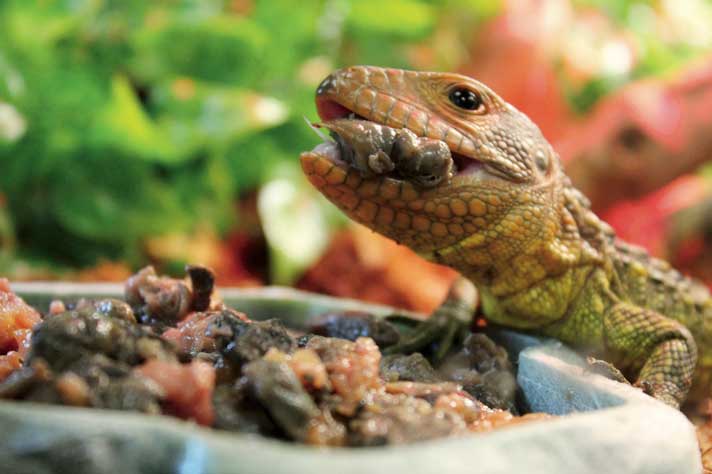
COURTESY DAVID FONTES
Caiman lizards are known for their specialized diet of aquatic snails.
Caiman Lizard Behavior and Handling
While our caiman lizards become active and excited at feeding time, they spend most of their remaining time basking. When temperatures rise, a quick dip in the water cools them down, and then they are back to lounging around in the sun. At night, they may remain in the branches to sleep or move down to sleep under one of the hides on the land area.
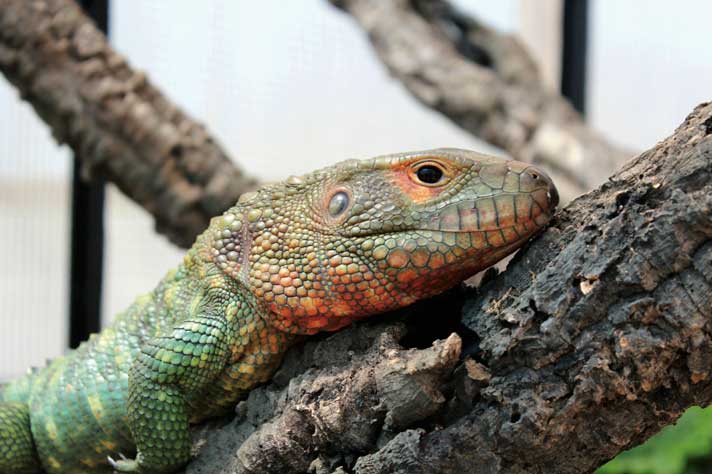
courtesy david Fontes
Covered in large bony scales, the skin of a caiman lizard resembles that of a caiman, its crocodilian namesake.
Although caiman lizards are not naturally aggressive, they may require some training to become handleable. We avoid reaching into their enclosure, as these enthusiastic eaters may get too excited and mistake a hand for food. When we do handle one of our caiman lizards, it is first coaxed to the door using a target pole. Once at the door, it can easily be lifted from the enclosure.
Caiman lizards seem to be very smart and learn quickly. Ours have learned to recognize their food dish and come eagerly to the feeding area when a keeper approaches with it. If no food dish is in hand, the lizards calmly watch as work is done around the enclosure. If keepers are carrying feeding tongs, the lizards position themselves within reach of the door and wait for treats to be delivered.
When they were smaller and living in an indoor enclosure, handlers had to constantly find ways to “trick” these very clever creatures. On the main feeding days (Monday, Wednesday and Friday), the lizards would anticipate keeper interaction and even start pushing the screen top off of their tank. We had to randomly change our routine by coming in through different doors, approaching different sides of the tank and hiding the food dish so that the lizards didn’t come out of the enclosure as soon as it was opened. Eventually, feeding became a two-person operation, with one distracting the lizards at one end of the enclosure with snails and feeding tongs while the other replaced the previous dish with a new dish of fresh food.
Caiman Lizard Health Watch
With good husbandry, correct temperatures, proper humidity, an appropriate diet and good hygiene, many health issues can be avoided. A major concern, especially with new imports, is internal parasites. Stress from shipping and frequent movement can impair a caiman lizard’s immune system and reduce its ability to fight infection. Newly acquired animals should be allowed to acclimate to their new environment, and a fecal sample should be taken to a reptile vet for analysis. Resist the temptation to begin handling the lizard until it has begun eating regularly and settles in. Other health concerns include respiratory infection, ear infections, shedding problems and external wounds. It is important to observe animals and be aware of behavioral changes that may indicate a health problem so that a qualified reptile veterinarian can be contacted immediately. Once established, caiman lizards are fairly hardy, and if provided with suitable environmental conditions and proper husbandry, they can thrive as pets.
Caiman Lizard CITES Appendix II
Dracaena guianensis is listed on Appendix II of the Convention on International Trade in Endangered Species (CITES), and because of this protection, virtually all caiman lizards in today’s pet trade are farmed or captive bred. Once considered difficult to keep, keepers have more success acclimating these animals to captivity than was possible with previous wild-collected specimens. Caiman lizards still are not frequently found in local pet shops, but some reptile specialty stores and online resources occasionally have them available, and at more reasonable prices than in years past. Armed with knowledge, the proper equipment and an undying love and fascination for these animals, some reptile enthusiasts have become increasingly successful with maintaining caiman lizards in captivity. However, as intriguing and tempting as it may be to own one, the caiman lizard is not a pet for everyone due to its specialized needs. Do not obtain one unless you have thoroughly researched and are able to provide it with proper care.
Conclusion
Caiman lizards are beautiful reptiles that can be fun, interactive pets for the devoted enthusiast. For a lizard fan with the time and resources to dedicate, they can be very rewarding to keep, and with their growing popularity in the pet trade, we are sure to learn more about keeping and breeding these captivating creatures.
Ashley Rademacher holds a degree in exotic animal training and management, with emphasis on behavior management and wildlife education from Moorpark College. She is currently the Animal Care and Education Coordinator at Zoo Med Labs and helps take care of their large, diverse animal collection. Although she has been working with the animals at Zoo Med since 2008, she has kept and bred reptiles for most of her life and still has her first pet reptile—a 20-year-old female green iguana named Blue.

